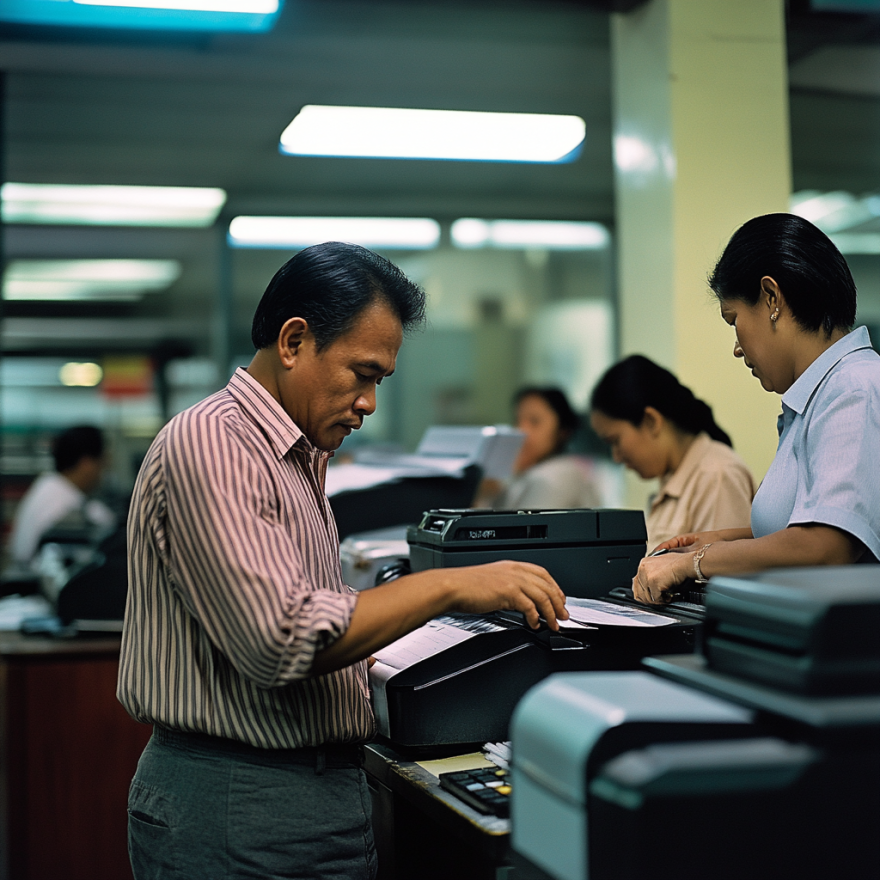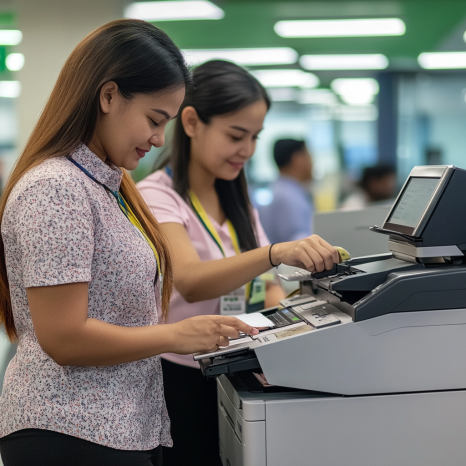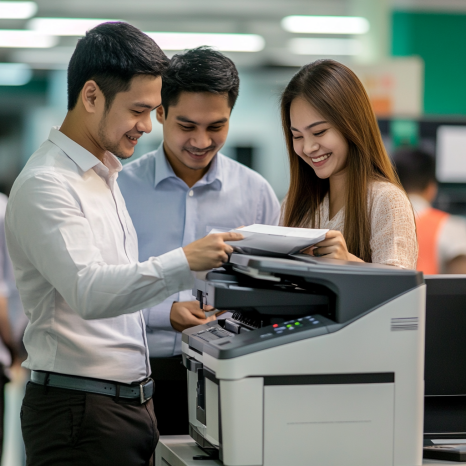
Energy-efficient Printers
Part 1: The Importance of Energy-Efficient Printers in Modern Business
Energy-efficient Printers: In today’s environmentally conscious world, energy efficiency has become a critical factor for businesses looking to reduce their carbon footprint and operational costs. Energy-efficient printers are an essential component of this shift, offering numerous benefits that extend beyond just lower energy bills. This section explores the importance of energy-efficient printers, how they contribute to sustainability goals, and the key features that make them a smart choice for any business.
What is a Printer Rental?
A printer rental is a service that allows businesses to rent high-quality printing equipment for a specified period, which can range from just a few days to several months. This option provides flexibility for event organizers and businesses who need to access premium printers without committing to a long-term purchase. Whether you require a single printer for a small gathering or multiple units for a large conference, printer rentals offer scalable solutions to meet the varying demands of your event.
To get started with printer rentals, our Introduction to Printer Rentals guide is an excellent resource for beginners, helping you make informed decisions that suit your business needs.
For businesses looking to boost productivity, utilizing the best printers for office use can enhance efficiency and improve workflow. Additionally, our insights into the cost of printer rentals provide valuable tips for effective budgeting and cost-saving strategies.
When weighing the benefits of printer rentals vs. purchasing, our detailed analysis will guide you in selecting the option that aligns best with your business objectives. To discover the variety of available options, explore our types of printers for rent, each tailored to meet specific business requirements.
For a deeper understanding of the flexibility and terms offered by our printer rental contracts, visit our site. This information will help you select the ideal rental agreement, whether you need short-term or long-term rentals.
Lastly, ensure that your event is equipped with reliable, high-quality printing solutions by opting for eco-friendly printer rentals. These rentals not only support sustainability but also guarantee a smooth and efficient printing experience, elevating your event to the next level.
Why Energy Efficiency Matters in Printing
Energy efficiency in printing is about more than just saving on electricity bills. It’s a crucial aspect of a company’s broader sustainability strategy, reflecting a commitment to reducing environmental impact and promoting responsible resource use. By investing in energy-efficient printers, businesses can achieve several key objectives:
Reduced Energy Consumption: Energy-efficient printers consume significantly less electricity compared to traditional models. This reduction is achieved through advanced technologies that minimize power usage during operation, standby, and sleep modes. The result is lower energy bills and a reduced environmental impact, aligning with corporate sustainability goals.
Lower Carbon Footprint: The carbon footprint of a business is directly linked to its energy consumption. By choosing energy-efficient printers, companies can decrease their greenhouse gas emissions, contributing to the fight against climate change. This not only benefits the environment but also enhances the company’s reputation as a responsible corporate citizen.
Cost Savings: While energy-efficient printers may come with a slightly higher upfront cost, the savings in energy bills over time can more than offset this initial investment. Businesses can also benefit from potential tax incentives and rebates offered for energy-efficient equipment, further enhancing the financial benefits.
Compliance with Environmental Regulations: Many countries have implemented strict environmental regulations that require businesses to reduce their energy consumption and carbon emissions. Using energy-efficient printers helps companies comply with these regulations, avoiding potential fines and enhancing their standing with regulatory bodies.
Key Features of Energy-Efficient Printers
Energy-efficient printers are designed with several innovative features that make them more sustainable and cost-effective than traditional printers. Here are some of the key features to look for when selecting an energy-efficient printer:
Low Power Consumption: Energy-efficient printers are equipped with power-saving modes that reduce energy use when the printer is not actively printing. These modes, such as sleep or standby, can significantly cut down on electricity usage during idle periods.
Automatic Duplex Printing: One of the simplest ways to reduce paper waste is through duplex printing, which prints on both sides of the paper. Many energy-efficient printers come with automatic duplexing as a standard feature, helping to conserve resources and reduce operational costs.
ENERGY STAR Certification: ENERGY STAR is a globally recognized certification for energy efficiency. Printers that carry the ENERGY STAR label have been tested and proven to meet strict energy efficiency guidelines set by the Environmental Protection Agency (EPA). Choosing an ENERGY STAR-certified printer ensures that you are investing in a product that meets high standards of energy conservation.
Eco-Friendly Consumables: In addition to energy efficiency, many modern printers are designed to use eco-friendly consumables, such as recycled paper and non-toxic inks. These features further reduce the environmental impact of printing operations.
Efficient Warm-Up Times: Energy-efficient printers often have faster warm-up times, meaning they reach optimal operating temperatures more quickly and use less energy in the process. This not only speeds up printing tasks but also contributes to overall energy savings.
The Role of Energy-Efficient Printers in Sustainability Initiatives
Incorporating energy-efficient printers into your business operations is a significant step toward achieving broader sustainability goals. These printers not only reduce energy consumption but also play a key role in minimizing waste and promoting responsible resource use. Here’s how energy-efficient printers contribute to sustainability initiatives:
Supporting Corporate Sustainability Goals: Many companies have set ambitious sustainability targets, such as reducing energy use by a certain percentage or achieving carbon neutrality. Energy-efficient printers help support these goals by lowering the energy needed for daily operations and reducing the overall environmental impact of the company’s activities.
Enhancing Corporate Reputation: In today’s market, consumers and clients are increasingly favoring businesses that demonstrate a commitment to sustainability. By adopting energy-efficient printing practices, companies can enhance their reputation as environmentally responsible organizations, which can lead to increased customer loyalty and attract new business opportunities.
Reducing Operational Costs: Sustainability is not just about environmental benefits; it also makes good business sense. The cost savings associated with reduced energy consumption can be significant, especially for large organizations with extensive printing needs. By lowering operational costs, energy-efficient printers contribute to a healthier bottom line.
Promoting Employee Engagement: Employees are more likely to feel proud of and engaged with a company that takes sustainability seriously. By implementing energy-efficient practices, including the use of energy-efficient printers, businesses can foster a culture of environmental responsibility and encourage employees to take part in sustainability initiatives.
FAQs
What makes a printer energy-efficient?
- Energy-efficient printers are designed with features that reduce power consumption, such as sleep modes, efficient warm-up times, and low-energy settings. Many also carry certifications like ENERGY STAR, which verifies their energy efficiency.
How do energy-efficient printers contribute to cost savings?
- By consuming less electricity, energy-efficient printers lower your energy bills. Over time, these savings can offset the initial cost of the printer, making it a cost-effective choice for businesses. Additionally, companies may qualify for tax incentives or rebates for using energy-efficient equipment.
Are energy-efficient printers less powerful or slower than traditional printers?
- No, energy-efficient printers are designed to maintain high performance while using less energy. Many models offer fast printing speeds, high-quality output, and robust features that are on par with or superior to traditional printers.
What certifications should I look for in an energy-efficient printer?
- Look for printers that are ENERGY STAR certified. This certification ensures that the printer meets strict energy efficiency guidelines and has been tested for performance and sustainability.
Can energy-efficient printers handle large printing volumes?
- Yes, many energy-efficient printers are designed to handle large volumes of printing without compromising on speed or quality. They are suitable for businesses of all sizes, from small offices to large corporations.

Part 2: Implementing and Maintaining Eco-Friendly Printing Practices
Implementing eco-friendly printing practices is essential for reducing environmental impact and promoting sustainability within your organization. However, maintaining these practices requires careful planning, regular maintenance, and a commitment to continuous improvement. This section will explore how to effectively implement and maintain eco-friendly printing practices, including the benefits of printer rentals, key maintenance strategies, and troubleshooting tips.
Implementing Eco-Friendly Printing Practices
The first step in adopting eco-friendly printing practices is to choose the right equipment and materials. Here are some key considerations:
Selecting Sustainable Printers: One of the most important decisions in implementing eco-friendly printing practices is choosing the right printer. Eco-friendly printers are designed to minimize energy consumption, reduce waste, and use environmentally friendly materials. Look for printers that are ENERGY STAR certified, support duplex printing (which reduces paper usage), and use non-toxic, recyclable ink cartridges.
Using Recycled and Sustainable Materials: Another key aspect of eco-friendly printing is the use of recycled and sustainable materials. This includes using recycled paper, soy-based inks, and other materials that have a lower environmental impact. Additionally, consider implementing a paper recycling program within your organization to further reduce waste.
Optimizing Print Settings: Adjusting your printer settings can also make a significant difference in reducing waste. Encourage your team to use draft mode for internal documents, which uses less ink, and to print double-sided whenever possible. These small changes can add up to substantial savings in both resources and costs.
Training and Education: To ensure the success of your eco-friendly printing initiatives, it’s important to educate your staff about the benefits of these practices and how to implement them effectively. Regular training sessions can help reinforce the importance of sustainability and ensure that everyone in your organization is on board with your green initiatives.
Maintaining Eco-Friendly Printing Practices
Once eco-friendly printing practices are in place, it’s crucial to maintain them through regular maintenance, troubleshooting, and continuous improvement. Here’s how to keep your green printing initiatives running smoothly:
Regular Printer Maintenance: Keeping your printers in good working condition is essential for maintaining eco-friendly practices. Regular maintenance can prevent issues that lead to wasted resources, such as paper jams or inefficient ink usage. Follow the manufacturer’s recommended maintenance schedule and consider working with a service provider to handle more complex tasks.
Monitoring Ink and Paper Usage: Keeping track of how much ink and paper your organization uses can help you identify areas for improvement. Regularly review usage reports and look for patterns that indicate wasteful practices. For example, if you notice a high volume of single-sided printing, consider reminding staff to use duplex printing whenever possible.
Troubleshooting Common Issues: Even with the best equipment, problems can arise. Common issues like paper jams, streaky prints, or connectivity problems can disrupt your printing processes and lead to waste. Developing a troubleshooting guide for common printer issues can help your team quickly resolve problems and minimize downtime.
Upgrading to the Latest Technology: As printing technology evolves, new eco-friendly features become available. Regularly evaluate your equipment and consider upgrading to more efficient models as part of your long-term sustainability strategy. Renting printers can also be a cost-effective way to access the latest technology without the need for a significant upfront investment. Understanding how printer rentals work can help you make informed decisions about when to rent versus when to purchase new equipment.
Troubleshooting and Common Challenges
While implementing and maintaining eco-friendly printing practices offers numerous benefits, there are also challenges that organizations may face. Being prepared for these challenges and having a plan in place to address them can help ensure the success of your sustainability efforts.
Dealing with Resistance to Change: Some employees may be resistant to adopting new practices, especially if they involve changes to their daily routines. To overcome this resistance, emphasize the benefits of eco-friendly printing, such as cost savings, environmental impact, and improved corporate responsibility. Providing clear instructions and making the transition as seamless as possible can also help reduce pushback.
Managing Costs: While eco-friendly printers and materials can lead to long-term savings, there may be initial costs associated with upgrading equipment or purchasing sustainable supplies. To manage these costs, consider budgeting for these expenses in advance and exploring options like leasing printers, which can spread out the costs over time.
Ensuring Consistent Quality: One concern with eco-friendly printing practices is that they might compromise print quality, especially when using recycled paper or non-toxic inks. However, advancements in technology have largely mitigated these issues. It’s important to select high-quality eco-friendly products and to regularly calibrate your printers to ensure consistent output.
Navigating Legal and Policy Considerations: When implementing eco-friendly practices, it’s important to be aware of any legal or policy requirements that may apply. This could include regulations around the disposal of electronic waste, compliance with environmental standards, and ensuring that your printer rental contracts align with your sustainability goals.
FAQs
What should I look for in an eco-friendly printer?
- Look for features like ENERGY STAR certification, duplex printing capabilities, and the use of non-toxic, recyclable ink cartridges. These features help minimize energy consumption, reduce waste, and support sustainability efforts.
How can I reduce paper usage in my organization?
- Encourage duplex printing, use digital documents whenever possible, and implement a paper recycling program. Training your staff on these practices can significantly reduce paper waste.
What are the benefits of regular printer maintenance?
- Regular maintenance prevents issues like paper jams and inefficient ink usage, which can lead to wasted resources. It also extends the lifespan of your printers, reducing the need for replacements.
What are common challenges when adopting eco-friendly printing practices?
- Common challenges include resistance to change, managing upfront costs, ensuring consistent print quality, and navigating legal and policy considerations. Addressing these challenges with a clear plan can help ensure the success of your sustainability initiatives.
How can printer rentals support eco-friendly practices?
- Renting printers allows you to access the latest eco-friendly technology without the upfront costs of purchasing. It also provides flexibility, allowing you to upgrade equipment as needed to maintain your green initiatives.

Part 3: Legal Considerations, Maintenance, and Future Trends in Eco-Friendly Printing Practices
While adopting eco-friendly printing practices is crucial for sustainability, understanding the legal aspects, maintenance needs, and future trends in this area is equally important. This section will cover the legal and contractual considerations involved in eco-friendly printing, the importance of proper maintenance and troubleshooting, and the emerging trends that will shape the future of green printing practices.
Legal and Contractual Considerations for Eco-Friendly Printing
When implementing eco-friendly printing practices, businesses must be aware of the legal and contractual obligations that come with it. These considerations ensure that your practices not only comply with environmental regulations but also protect your organization from potential liabilities.
Compliance with Environmental Regulations: Various laws and regulations govern the environmental impact of printing practices. Compliance with these regulations is essential to avoid fines and legal issues. This includes adhering to guidelines on the disposal of printing waste, the use of non-toxic inks, and the energy efficiency of printing equipment. Ensuring your practices align with these regulations demonstrates your commitment to sustainability and corporate responsibility.
Contracts with Suppliers and Vendors: If your organization rents printers or works with external printing services, it’s important to include clauses in your printer rental contracts that specify eco-friendly requirements. This might include the use of sustainable materials, adherence to energy efficiency standards, and proper waste disposal practices. Clear contractual terms ensure that your partners are aligned with your environmental goals.
Liability and Insurance Considerations: Businesses should also be aware of the potential liabilities associated with eco-friendly printing practices. This includes ensuring that your equipment meets safety standards and that your waste disposal methods do not violate environmental laws. Additionally, it’s wise to review your insurance policies to ensure they cover any potential risks associated with eco-friendly printing equipment.
Amendments in Contracts: As environmental standards evolve, so too might your contracts with suppliers and service providers. It’s essential to include provisions for amendments in contracts, allowing your business to adjust terms as needed to remain compliant with new regulations or to adopt more sustainable practices.
Maintenance and Troubleshooting for Sustainable Printers
Maintaining eco-friendly printers is critical to ensuring their longevity and efficiency. Proper maintenance not only keeps the printers running smoothly but also supports your organization’s sustainability efforts by minimizing waste and energy use.
Regular Maintenance: Regular maintenance is crucial for keeping eco-friendly printers in optimal condition. This includes routine cleaning, checking for worn parts, and updating software to ensure the printer operates efficiently. Regular maintenance can also prevent larger issues from arising, reducing the need for costly repairs or replacements.
Troubleshooting Common Issues: Even with regular maintenance, printers may encounter issues that require troubleshooting. Common problems include paper jams, connectivity issues, and low print quality. Having a troubleshooting guide on hand can help quickly resolve these problems without disrupting your printing operations. Understanding the maintenance costs associated with eco-friendly printers can also help in budgeting for repairs and replacements.
Sustainable Repair Practices: When repairs are needed, it’s important to consider sustainable practices. This includes using refurbished or recycled parts whenever possible and ensuring that any old or broken components are disposed of in an environmentally friendly manner. Working with service providers who specialize in eco-friendly repairs can further support your sustainability goals.
Importance of Technical Support: Ensuring that your eco-friendly printers are supported by reliable technical service is key to minimizing downtime and maintaining efficiency. Many printer rentals include technical support as part of the package, which can be invaluable for troubleshooting and repair needs.
Future Trends in Eco-Friendly Printing
As technology continues to evolve, so too will the practices and technologies associated with eco-friendly printing. Staying ahead of these trends can help your organization remain competitive and continue to reduce its environmental impact.
Advancements in Sustainable Materials: One of the most exciting trends in eco-friendly printing is the development of new sustainable materials. This includes biodegradable inks, recyclable paper, and even printable electronics that reduce the need for traditional materials. Staying informed about these advancements can help your business adopt the latest eco-friendly practices.
Energy-Efficient Printing Technologies: Future developments in printing technology are expected to focus heavily on energy efficiency. This includes printers that use less power during operation and new technologies that reduce the energy required for printing processes. Adopting these sustainable printers will further reduce your organization’s carbon footprint.
Integration with Digital Solutions: The integration of digital and cloud-based solutions with eco-friendly printing is another trend to watch. Digital workflows that minimize the need for physical printing, combined with printers that can seamlessly integrate with cloud services, will likely become more prevalent. This shift can reduce paper usage and streamline printing processes, making them more efficient and sustainable.
Circular Economy Practices: The concept of a circular economy, where products are reused, refurbished, and recycled, is gaining traction in the printing industry. This approach reduces waste and the demand for new resources. By participating in circular economy initiatives, your organization can further enhance its sustainability efforts.
Customization and On-Demand Printing: The move towards customization and on-demand printing is also contributing to eco-friendly practices. By printing only what is needed, when it’s needed, businesses can significantly reduce waste. On-demand printing technologies are expected to become more advanced, offering faster turnaround times and higher quality outputs.
FAQs
What legal considerations should be taken into account with eco-friendly printing?
- Legal considerations include compliance with environmental regulations, ensuring that contracts with suppliers and service providers specify eco-friendly practices, and managing liability related to the use of sustainable printing equipment. It’s also important to review insurance policies to cover potential risks.
How can regular maintenance of eco-friendly printers support sustainability goals?
- Regular maintenance ensures that eco-friendly printers operate efficiently, reducing energy consumption and minimizing waste. It also extends the lifespan of the printer, reducing the need for replacements and contributing to overall sustainability efforts.
What are some common troubleshooting tips for eco-friendly printers?
- Common troubleshooting tips include checking for paper jams, ensuring proper connectivity, and addressing low print quality by cleaning print heads or replacing ink cartridges. Keeping a troubleshooting guide handy can help quickly resolve issues and minimize disruptions.
How can businesses integrate circular economy practices into their printing operations?
- Businesses can integrate circular economy practices by using recycled or refurbished printer parts, participating in take-back programs for old equipment, and choosing printers designed for easy recycling. This approach reduces waste and supports a more sustainable printing lifecycle.
What future trends should businesses watch for in eco-friendly printing?
- Businesses should watch for advancements in sustainable materials, energy-efficient printing technologies, integration with digital solutions, and the growing importance of the circular economy in printing practices. Staying informed about these trends can help businesses adopt the latest and most effective eco-friendly practices.

To learn more about sustainable copier rental solutions and how Marga Enterprises can support your green initiatives, contact us today at 09171642540 or 09614481276. You can also reach us via email at marga.enterprises2013@gmail.com. Let’s work together to build a greener, more sustainable future for generations to come. Visit Marga Enterprises and find out why we are the No. 1 Copier & Printer Rental Provider in the Philippines.
Join our growing community on Facebook and Youtube for exclusive content and discussions designed to propel your business forward. Follow our posts and be part of the conversation!
